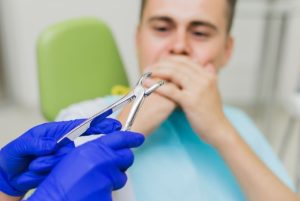Wisdom teeth, or third molars, are the last teeth to develop. They typically appear between ages 17 and 25 — the stage in life often associated with reaching “wisdom,” hence the name. While they served a purpose for our ancestors who ate tough, fibrous diets, modern lifestyles have made them somewhat redundant.
Today, our jaws are generally smaller, and many people simply don’t have the space for these teeth to come through properly. That lack of space is what often leads to the complications we associate with wisdom teeth.
According to the NHS, wisdom teeth are only removed if they cause repeated issues or have a high likelihood of doing so in the future.
Symptoms That Might Mean Trouble
Not every wisdom tooth causes symptoms, but when problems do occur, they can include:
- Persistent jaw pain or discomfort at the back of the mouth
- Swelling of the gums near the emerging tooth
- Difficulty opening the mouth fully
- Bad breath or a bad taste caused by trapped food and bacteria
- Crowding of nearby teeth
- Repeated gum infections
If you notice these symptoms, a dental assessment is important — not just to relieve discomfort, but to prevent more serious complications.
Common Problems Caused by Wisdom Teeth
Wisdom teeth can be erupted (fully through the gums) or impacted (partially or fully trapped under the gums). Impacted wisdom teeth are more likely to cause:
- Impaction – The tooth grows at an angle, pressing into the gum, jawbone, or neighbouring teeth.
- Crowding – The new teeth push existing teeth out of alignment, affecting bite and appearance.
- Decay – Because they’re hard to clean, wisdom teeth are prone to cavities.
- Infections (Pericoronitis) – Food and bacteria get trapped under gum flaps, leading to inflammation.
- Cysts or tumours – Rare, but they can damage bone and nearby teeth if untreated.
Diagnosis and Decision-Making
If you suspect a wisdom tooth problem, your dentist will:
- Examine your mouth to check for inflammation, swelling, or crowding.
- Take X-rays to see the exact position of the teeth and the surrounding bone structure.
- Assess symptoms and history – repeated infections or ongoing pain increase the likelihood of removal.
In some cases, dentists recommend a “wait and watch” approach, especially if the teeth are not currently causing problems but could in the future.
Preparing for Surgery
Wisdom tooth surgery is generally straightforward, but preparation helps the process go smoothly. Your dental team will explain:
- The type of anaesthetic to be used (local, sedation, or general)
- How long the procedure will take (often 20–60 minutes)
- Aftercare essentials such as diet changes and activity restrictions
- Any potential risks specific to your situation
The NHS notes that most people recover fully within a few days to two weeks, depending on the tooth’s position and the complexity of removal.
The Surgery Process in Detail
Step 1 – Anaesthetic
You’ll be numbed locally or sedated to ensure comfort. General anaesthetic is used in hospital settings for more complex cases.
Step 2 – Accessing the Tooth
A small incision may be made in the gum, and sometimes a small section of bone is removed to reach the tooth.
Step 3 – Sectioning the Tooth (if needed)
In some cases, the tooth is cut into smaller pieces for easier removal.
Step 4 – Cleaning and Closing
Any debris is cleared, and dissolvable stitches may be placed.
 Recovery and Aftercare Tips
Recovery and Aftercare Tips
Recovery is just as important as the surgery itself. Good aftercare can reduce the risk of complications.
| Recovery Day | What to Do | What to Avoid |
| Day 1–2 | Use ice packs for swelling, take prescribed pain relief, eat soft foods, avoid touching the wound | Hot drinks, alcohol, smoking, vigorous rinsing |
| Day 3–5 | Gentle saltwater rinses after meals, continue soft diet | Hard/crunchy foods, poking at the wound |
| Day 6+ | Gradually return to normal diet, maintain gentle oral hygiene | Strenuous exercise until swelling subsides |
Extra tips:
- Keep your head elevated when resting to reduce swelling
- Stay hydrated but avoid straws (suction can dislodge the clot)
- Brush gently around the surgical site to avoid irritation
Potential Risks and Complications
While wisdom tooth removal is safe and routine, possible risks include:
- Swelling, bruising, and mild bleeding
- Dry socket – a painful condition where the blood clot dislodges
- Temporary numbness from nerve irritation
- Jaw stiffness during the first few days
Following your dentist’s instructions closely reduces these risks significantly.
Prevention: Can Problems Be Avoided Without Surgery?
In some cases, yes — especially if the wisdom teeth have erupted normally and are easy to clean. Good oral hygiene, including brushing, flossing, and regular dental check-ups, can keep them healthy. However, impacted teeth or those causing repeated infections often need post-treatment care options as a long-term solution.
Key Takeaways
- Wisdom teeth can cause problems when there’s not enough room for them to grow properly
- Symptoms like swelling, pain, or crowding should be checked promptly by a dentist
- Removal decisions are based on symptoms, X-rays, and oral health history
- Recovery usually takes a few days, but complete healing can take up to two weeks
- Following aftercare instructions is essential to prevent complications like dry socket
Caring for Your Mouth After Wisdom Teeth Removal
Your mouth’s healing process continues beyond the first week. Once stitches dissolve and swelling goes down, focus on gentle but thorough cleaning and keeping your regular dental appointments. Preventive care will help ensure that the rest of your teeth stay healthy long after your wisdom teeth are gone.
FAQs
Do all wisdom teeth need to be removed?
No — if they grow in properly and don’t cause problems, they can be left in place.
How long does recovery take?
Most people feel fine within 3–7 days, but full healing can take up to two weeks.
Is the surgery painful?
The procedure itself is painless due to anaesthetic. Some discomfort afterward is normal and can be managed with medication.
Can I work the day after surgery?
It depends on the complexity of the surgery and your job. Most people take at least 1–2 days off.
What’s the best way to avoid dry socket?
Follow aftercare advice carefully — avoid smoking, alcohol, and drinking through straws for at least a week.

